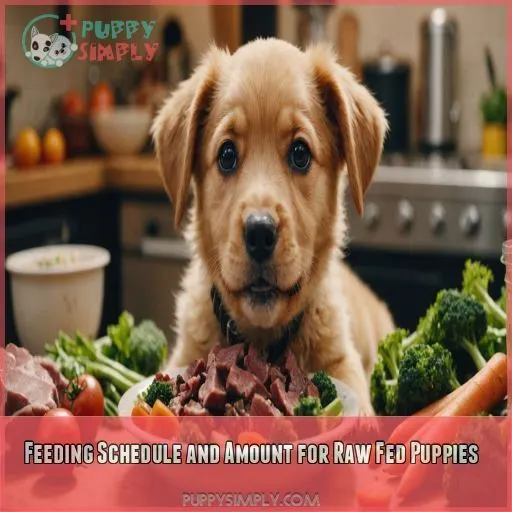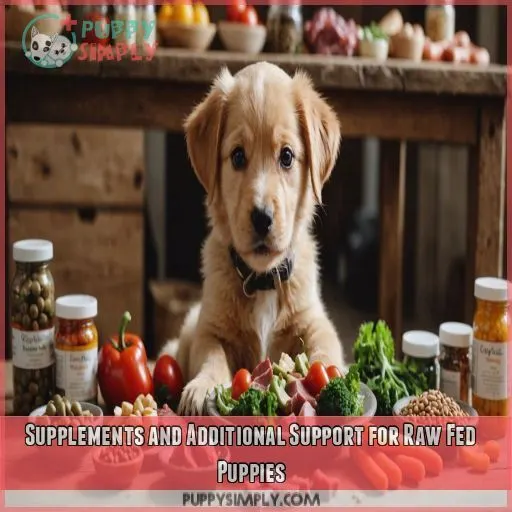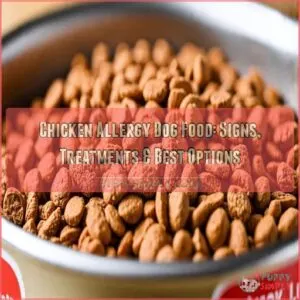This site is supported by our readers. We may earn a commission, at no cost to you, if you purchase through links.

A raw diet can boost your puppy’s health and energy naturally, providing essential proteins and nutrients for strong bones and a healthy immune system. It’s like giving them a tailor-made superhero cape for tackling puppyhood!
However, it’s essential to balance it right—think meaty bones, organ meats, and careful portioning. You’ll want to make sure they’re not missing out on anything their little bodies need.
Curious about how to perfect their menu? Stick around for more insights!
Table Of Contents
- Key Takeaways
- Benefits of Raw Feeding for Puppies
- Choosing the Right Raw Diet for Your Puppy
- Feeding Schedule and Amount for Raw Fed Puppies
- Common Concerns and Considerations for Raw Fed Puppies
- Supplements and Additional Support for Raw Fed Puppies
- Frequently Asked Questions (FAQs)
- Is a raw diet good for puppies?
- At what age can you start a puppy on a raw diet?
- What is the best diet for a growing puppy?
- How do I start my puppy on a raw diet?
- How to safely introduce raw bones to puppies?
- What are the signs of raw food allergies?
- When should organ meats be included in diet?
- Are there risks with a raw diet transition?
- How to store raw food for freshness?
- Conclusion
Key Takeaways
- A raw diet can turn your puppy into a dynamo with energy, a dazzling coat, and fewer kibbles in their bowl. It’s like finding a hidden springboard in their kibble dish! However, it’s key to keep it balanced with meaty bones and organ meats to fuel their superhero growth.
- Allergies and tummy troubles might become old news as raw feeding uses fresh, quality ingredients that sidestep common allergens raw food benefits.
. It’s like swapping a sneezy season for a smooth ride through puppyhood.
- Feeding raw can mean shinier coats and healthier skin, turning your pup into the neighborhood’s furry fashion model. omega-3s from a natural raw diet can replace those fancy hair supplements.
- Expect puppy zoomies powered by a nutrient-rich raw diet. Their boundless energy will keep you on your toes as they tackle training and mischief with gusto. Just be ready for some serious playtime!
Benefits of Raw Feeding for Puppies
Feeding your puppy a raw diet can offer them a nutrient-packed start, promoting strong growth without you needing to worry about complex calculations raw diet for Huskies.
. Plus, you might notice fewer sneezes and shinier fur, keeping your new friend healthy and happy with each tail wag.
Nutrient-Rich Diet for Optimal Growth
Feeding your growing puppy a nutrient-rich raw diet for dogs can work wonders for their development.
. This natural, whole-food approach provides the essential proteins, fats, and minerals puppies need to build strong bones, muscles, and a healthy immune system
. Plus, you’ll likely notice a boost in their energy and overall health.
Reduced Risk of Allergies and Sensitivities
Switching to a raw food diet may reduce puppy food allergies and sensitivities. By using high-quality, fresh raw food ingredients, you lower the risk of common allergens sneaking in like skin allergies.
. Watch for food sensitivity signs like itching or lack of energy. Remember, introducing new foods gradually is keylike tiptoeing into a cold poolit’s all about comfort and safety!
Improved Digestive Health
Switching to a raw diet can do wonders for your puppy’s digestion. If you’ve ever dealt with digestive issues, you’ll know it’s no walk in the park. Raw feeding supports gut health and stool consistency, making potty clean-ups a breeze. Probiotics in raw food recipes can ease the shift to raw food, helping your pup avoid tummy troubles.
.
Shinier Coat and Healthier Skin
Think of your puppy’s coat as a mirror to their healthglowing skin and a shiny coat often reflect a balanced raw diet packed with Omega-3 fatty acids. Ditch those coat supplements for natural sources! Raw food benefits include a boost to puppy health and potentially reducing skin allergies. Remember, a happy pup often means wagging tails and shinier fur.
Increased Energy Levels
With a raw diet, your puppy will have the energy to play, explore, and train like a champion! This nutrient-rich food fuels their boundless enthusiasm, helping them bound through training sessions and zoomies with ease. Plus, all that extra pep can make teaching new tricks a breeze. Get ready for a pup with pep in their step!
Choosing the Right Raw Diet for Your Puppy
Choosing the right raw diet for your puppy can feel like trying to find the perfect pair of jeans—tricky but worth it when it fits just right! To keep your growing pup healthy, focus on a balanced diet with meaty bones and introduce organ meats carefully to provide all the essential nutrients they need.
Selecting a Balanced and Complete Diet
Balancing your puppy’s meals is like creating a symphony. Start with quality protein sources, ensuring a good meat-bone ratio. Choose a nutrient-dense puppy formula made specifically for their needs. Consider using supplements for a well-rounded diet. Remember, you’re setting the stage for healthy musculoskeletal development. Prioritize food safety, and watch them flourish like a pup on a sunny day!
Understanding the Importance of Meaty Bones
Who doesn’t love a wagging puppy tail? For strong bone development, a raw diet for growing puppies should include meaty bones. This helps keep a proper calcium and phosphorus balance. Keep your puppy’s meal schedule in check. Consider these natural sources:
- Chicken backs
- Turkey necks
- Beef neck bones
- Whole animals
- Raw food specialists’ dog food
Avoiding Synthetic Calcium Supplements
Ditch the synthetic calcium supplements – Mother Nature has you covered! Meaty bones like turkey necks and chicken backs provide a natural, bioavailable source of calcium and phosphorus, perfectly balanced for your pup’s growing bones. Avoid disrupting that delicate ratio with artificial additives. Trust the raw power of real food to nourish your four-legged friend.
| Synthetic Calcium | Natural Bone Sources |
|---|---|
| Unnatural | Bioavailable |
| Disrupts Balance | Maintains Balance |
| Potential Risks | Safe and Beneficial |
| Expensive | Cost-Effective |
| Unnecessary | Best Nutrition |
Introducing Organ Meats for Nutrient Variety
You’ve tackled synthetic calcium; now let’s talk organ meats. These nutritional powerhouses—like liver and kidney—should make up about 10% of your puppy’s diet. Start small to sidestep tummy troubles. Watch out for loose stools, adjusting portions if needed. It’s like giving your puppy superpowers without the cape! Alternatives like heart are great too. Variety’s the spice of life!
Tips for Customizing Your Puppy’s Raw Diet
When customizing your pup’s raw diet, you’ve got a lot to chew on, but don’t worry! Focus on:
- Transition timeline for gradual diet changes.
- Bone health by balancing meaty bones and soft options.
- Safely handle food to prevent contamination—your pup’s health is worth it.
You’ll avoid puppy food allergies and provide a safe, delicious diet.
Feeding Schedule and Amount for Raw Fed Puppies
Guiding your puppy through the right feeding schedule and portion control can feel like teaching a teen to moderate their pizza intake—balance is key! Pay close attention to their weight and energy levels; adjusting meals as they grow is essential to keeping them healthy and happy.
Feeding Frequency and Portion Control
Feeding your raw-fed puppy is all about finding the right rhythm. Start with three small meals a day until they hit six months – this prevents blood sugar dips and helps them get the nutrients they need to grow big and strong. As your pup matures, you can gradually shift to two or even one meal per day.
Adjusting Feeding Amount Based on Weight Gain or Loss
After setting your puppy’s feeding schedule, keep an eagle eye on their weight. If your puppy starts to resemble a plump little sausage, it’s time to cut back on the food to curb weight gain. On the flip side, if they’re as skinny as a rail, increase meal portions. Regularly monitor their growth, ensuring food amounts match their developmental needs.
Special Considerations for Small Breed Puppies
For tiny breeds, life’s a whirlwind—they’ve got the energy of a toddler on candy!
To dodge hypoglycemia risk, serve frequent meals, which keep their motors humming.
Prioritize bone development and dental health with proper portion control.
Picture mini-feasts throughout the day; it’s like taking snack breaks during a Netflix binge—except healthier.
They’ll thank you with puppy-eyed appreciation!
Gradually Reducing Meals as Your Puppy Grows
As your puppy matures, meal frequency needs adjustment. Make sure gradual changes for smooth puppy growth. It’s like teaching a teenager to manage their own snacks—slow and steady wins the race.
- Reduce from three to two meals a day.
- After six months, one meal might suffice.
- Observe digestive changes.
- Prioritize weight management by adjusting food amounts.
Stay the course, and enjoy playful puppy days!
Monitoring for Signs of Overfeeding or Underfeeding
As your puppy grows, keep a close eye on their weight, stool consistency, energy levels, and appetite. Use this handy table to spot signs of overfeeding or underfeeding, and make adjustments accordingly. With a little trial and error, you’ll find the perfect balance for your pup’s raw diet needs.
| Symptom | Potential Issue | Adjustment |
|---|---|---|
| Weight Gain | Overfeeding | Reduce portion size |
| Loose Stools | Overfeeding | Reduce portion size |
| Low Energy | Underfeeding | Increase portion size |
Common Concerns and Considerations for Raw Fed Puppies
Feeding your puppy a raw diet might seem like trying to juggle flaming torches, but with careful planning, you’ll keep everything cool and balanced. Remember to prevent tummy troubles by maintaining food safety, monitoring bone balance, and gradually introducing new foods to avoid pesky allergies.
Managing the Risk of Digestive Upset
Feeding frequency adjustments are like tuning a radio – get it right for smooth sailing!
Shifting slowly is key. Introduce new foods gradually, just like meeting new friends at a party: one at a time.
Keep a close eye on stool consistency – it’s your puppy’s way of texting you "all’s good!"
Hydration acts like the signpost to healthy digestion, so offer fresh water always.
Avoiding Contamination and Food Safety Risks
Let’s chat about food safety. You wouldn’t wear muddy boots inside, right? Similarly, practicing clean habits when handling your puppy’s meals is a must. Store meat properly, sanitize surfaces like it’s a secret to success, and keep water fresh. Prevent cross-contamination by treating your raw ingredients like they’re gold. Remember, a little caution keeps you in control.
Ensuring Adequate Calcium and Phosphorus Balance
Ensuring your puppy’s raw diet has the right balance of calcium and phosphorus is really important for healthy bone development. Focus on meaty bones like turkey necks and chicken backs – they provide a natural, bioavailable source of these essential minerals. Avoid relying on synthetic supplements, which can disrupt the natural balance in your pup’s body.
Tips for Introducing New Foods and Avoiding Allergies
How do you introduce new foods to your puppy without rocking the boat? Embrace these easy-peasy tips to dodge digestive upset and allergy pitfalls:
- New food switch: Ease in with one protein source initially.
- Allergy monitoring: Keep an eagle eye on reactions.
- Gradual introduction: Slowly mix in the new goodies.
- Celebrate success: Relish your puppy’s happy, wagging tail!
Addressing Common Health Issues in Raw Fed Puppies
Worried about digestive upset or coat problems?
Raw feeding can seem like figuring out a puzzle.
Keep dental health and parasite control excellent.
Imagine it as a dental spa for puppies!
Watch out for joint issues; think of them as squeaky wheels needing oil.
With a balanced diet, you can say goodbye to common health hiccups and hello to vibrant energy!
Supplements and Additional Support for Raw Fed Puppies
You’re not alone in wanting to make sure your puppy gets the best start with a raw diet, which is why understanding supplements like phytoplankton and probiotics is important. With a bit of research (and perhaps some trial and error), you can support your pup’s health and have them bounding with energy like they’ve got springs for paws!
Benefits of Phytoplankton and Nutritional Herbs
Phytoplankton and nutritional herbs can be game-changers for your raw-fed pup. These natural supplements pack a powerful punch, boosting their immune system, promoting healthy skin and coat, and supporting overall well-being. Plus, they’re easy to incorporate into your pup’s diet. Here are 4 key benefits:
- Antioxidant support
- Anti-inflammatory properties
- Enhanced nutrient absorption
- Improved gut health
Supporting Digestive Health With Probiotics and Enzymes
Adding phytoplankton is just the tip of the iceberg.
Let’s chat about probiotics and enzymes.
They’re like your puppy’s digestive cheerleaders, tackling raw food digestion like pros.
Different probiotic types line up for better gut health, while enzymes smooth out digestive issues.
It’s like a symphony for their little bellies.
Keep things balanced, and you’ll see a healthier, happier puppy!
The Role of Bovine Colostrum in Immune System Development
As you explore ways to boost your puppy’s health, bovine colostrum swoops in like a superhero for immune support. Think of it as gold dust for puppy immunity!
Consider these key points:
- Colostrum Benefits: Packed with antibodies.
- Colostrum vs. Milk: More nutrients.
- Colostrum Timing: Early introduction matters.
- Colostrum Sources: Available in supplements.
Providing Fresh Water and Adequate Exercise
Alongside bovine colostrum for immunity, don’t underestimate hydration and exercise.
Clean water is a thirst-quenching oasis for puppy hydration and joint health.
Imagine your pup as a tiny athlete ready for safe play.
Meet their exercise needs with short, playful sessions.
Overworking joints can be bone-tired; let them wag and wiggle without overdoing it.
Fresh water and frolics support their vibrant growth!
Seeking Guidance From Experienced Raw Feeders and Veterinarians
As you start your raw feeding journey, don’t go it alone! Tap into the wealth of knowledge from experienced raw feeders and your trusted veterinarian. They can provide invaluable guidance on:
- Safely moving your pup to a raw diet
- Addressing any health concerns or questions
- Connecting with a supportive raw feeding community
Their expertise can make all the difference in ensuring your puppy thrives on a raw diet.
Frequently Asked Questions (FAQs)
Is a raw diet good for puppies?
Exploring a raw diet for puppies can be like figuring out a culinary maze. It has its perks, like promoting fresh nutrients. But, it’s essential to balance properly and monitor for digestive hiccups. Consult your vet for guidance.
At what age can you start a puppy on a raw diet?
You can start your puppy on a raw diet as early as eight weeks old. Like teaching a teenager to drive, proceed cautiously and make sure bite-sized changes to accommodate your pup’s tender digestive system.
What is the best diet for a growing puppy?
Feeding a growing puppy is like crafting the perfect recipe. Focus on balance—protein for growth, carbs for energy, and fats for brain development. Mix in some humor and love, and you’ve got a happy pup!
How do I start my puppy on a raw diet?
To start your puppy on a raw diet, take it slow. Gradually introduce raw food over 1-2 weeks, watching for any digestive issues. Stick to one protein source at first, then slowly add variety. (Source)
How to safely introduce raw bones to puppies?
Introduce raw bones to puppies gradually, starting with smaller, softer options like chicken wings. Supervise them closely to avoid any "bone-headed" mishaps. This helps them gain essential nutrients without biting off more than they can chew (Source).
What are the signs of raw food allergies?
You might notice signs like itchy skin, excessive licking, ear infections, or upset stomach. Keep an eagle eye on your pup and consult your vet. Remember, it’s all about finding the right balance for your furry friend!
When should organ meats be included in diet?
Introduce organ meats to your puppy’s diet after at least two weeks of solid stools, starting with 10% of their diet. This gives time for their digestive system to adjust. Keep an eye on those stools!
Are there risks with a raw diet transition?
Switching your pup to raw can be a bumpy ride, but with patience and vigilance, you’ll navigate those tummy troubles. Just take it slow, one protein at a time, and you’ll have a happy, healthy raw-fed pup in no time!
How to store raw food for freshness?
To keep raw food fresh, tightly wrap it in air-tight containers and freeze it, preventing bacteria growth. Thaw in the fridge when needed, like giving your pup a chilled surprise party in their bowl (Source).
Conclusion
Choosing a raw diet for growing puppies can transform your energetic ball of fluff into a thriving symbol of health.
It’s like upgrading them from a toy car to a roaring engine.
Balancing meaty bones, organ meats, and natural supplements is key to enhancing their growth and vitality.
You’re not just feeding a puppy; you’re nurturing a future superhero.











